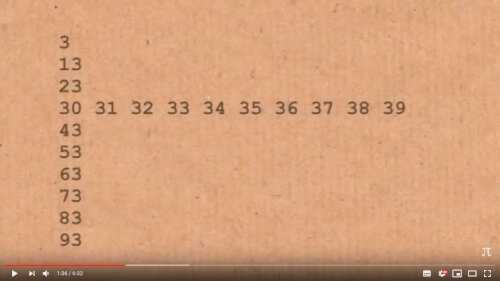Prouhet Thue Morse Suite
published: 29 April 2024 / updated 29 April 2024
article: 14 septembre 2019
Preamble
In a video of Numberphile, it's about the number of times the number 3
appears in the numbers. Link to the video:
https://www.youtube.com/watch?v=UfEiJJGv4CE

In binary, we have only the choice between the numbers 0 and 1.
The question is: what can be analyzed in the binary sequences?
An amazing sequence
The numbers from 0 to n, in binary are thus represented:
0 0 1 1 2 10 3 11 4 100 5 101 ....
Let's count the bits that are at 1
:
0 0 0 1 1 1 2 10 1 3 11 2 4 100 1 5 101 2 ....
Let's see how to automate the counting of these bits to 1
:
: binDigitCount ( d --- nb ) 0 >r \ count of digits "1" begin over \ duplicate low signifiant byte 1 and \ test lower byte if r> 1+ >r \ increment count of digits "1" then 2dup d0> \ test if not null while d2/ \ Arithmetic shift right by 1 repeat 2drop r> ;
The word binDigitCount processes a double precision number. It runs as follows:
3. bindigitCount . 2 ok 4. binDigitCount . 1 ok
Here is a loop for counting the bits of a sequence of integers from 0 to n:
: countLoop ( n ---) 0 do i . 3 spaces i s>d binDigitCount . cr loop ;
Execution of countLoop:
16 countLoop 0 0 1 1 2 1 3 2 4 1 5 2 6 2 7 3 8 1 9 2 10 2 11 3 12 2 13 3 14 3 15 4 ok
s there a hidden pattern in the sequence of bit counts at 1
?
The answer is: YES!
I will help you. We must not focus on the future itself, but on numbers that are even or odd:
0 1 1 2 1 2 2 3 1 2 2 3 2 3 3 4....
The Prouhet-Thue-Morse Suite
We will resume the loop, but showing:
- 0 if the number of bits at
1
is even - 1 if the number of bits at
1
is odd
: PTMloop cr 0 do i s>d binDigitCount 2 mod if s" 1" type else s" 0" type then loop ;
Execution of word PTMloop:
16 PTMloop 0110100110010110 ok 32 PTMloop 01101001100101101001011001101001 ok 64 PTMloop 0110100110010110100101100110100110010110011010010110100110010110 ok
This sequence has a particularity: the non-repetition of the sequences. Let's start from the sequence:
16 PTMloop 0110100110010110
It is found at the beginning of the following sequence:
32 PTMloop 01101001100101101001011001101001
Let's bring back to the next line the other half of the sequence:
32 PTMloop 0110100110010110 1001011001101001
The second half of the sequence is the binary opposite of the first half!
And it's the same for the third sequence:
64 PTMloop 01101001100101101001011001101001 10010110011010010110100110010110
This is how this Prouhet Thue Morse Suite is built:

The size of the footage is growing very, very fast.
This continuation has no periodicity:
- it is aperiodic and even ... random;
- there are never more than 2 identical adjacent terms;
- does not contain groups of three times the same digit;
- does not contain any XYXYX pattern with X = {0 or 1} and Y = {all following 0 and 1).
Reference: https://oeis.org/A010060
The PTM suite in decimal
This suite is written in decimal:
0.412 454 033 640....
Its development is infinite. It has been shown to be a transcendent number, at the same title as PI.
In mathematics, a transcendental number is a real number or complex number that is not an algebraic number—that is, not a root (i.e., solution) of a nonzero polynomial equation with integer coefficients.
